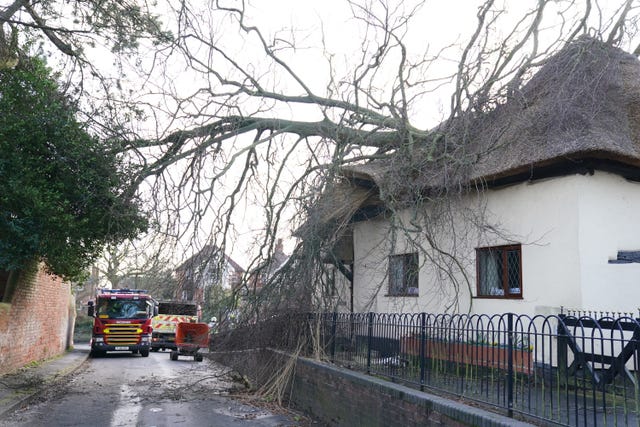Scientists reveal cause of deadly storms which battered UK in space of a week
Researchers says the finding could help forecasters identify any increased risk of storm clusters up to a month before they happen.

Three storms which battered the nation within the space of a week leaving 1.4 million households without electricity were caused by a “swirling polar vortex” miles above the Earth, scientists have said.
Four people lost their lives when storms Dudley, Eunice and Franklin hit the UK in February 2022, bringing 120mph winds and severe flooding.
It marked the first time three named storms have been recorded within seven days since the storm-naming system began in 2015.

According to new research, the cluster was connected to stronger winds in the Arctic stratosphere.
Experts believe the finding could help forecasters identify any increased risk of storm clusters up to a month before they happen.
Storm Eunice was described as a once-in-a-decade event and the most severe since 2014, with record wind gusts for England of 122mph recorded at the Needles on the Isle of Wight, the Met Office said.
February 2022 was characterised by an extremely strong stratospheric polar vortex (SPV) – a large spinning mass of cold air in the stratosphere around 15 miles above the Arctic that is prominent during winter months, the findings published in the journal Communications Earth and Environment show.
Researchers concluded that the strong SPV made it up to three times more likely that there would be intense storms affecting the UK and northern Europe during February 2022.

Their results also reveal that the strong SPV at that time increased the likelihood of three or more storms reaching the UK in a single week by around 80% compared with when the SPV is normal.
Crucially, the researchers say that the signal for a strong SPV was evident from forecasts carried out as early as November 2021 and that spotting these conditions could offer a window of opportunity for enhanced European predictability.
Lead author Dr Ryan Williams, who carried out the research while at the University of Leeds, said: “Our research demonstrates the need to better understand the different drivers of the North Atlantic storm track, such as the state of the stratospheric polar vortex that is potentially predictable several weeks in advance.
“Being able to provide early warnings of possible severe weather is all the more pertinent with climate change, as there is evidence that major winter storms will become more intense, exacerbating impacts such as flooding and wind damage.”
Co-author Jeff Knight, the science lead in monthly to decadal prediction at the UK Met Office, said: “It’s been understood for a while that the Arctic stratosphere can affect the type of winter we get in the UK, but these results show that it can even affect the occurrence of stormy spells within the season.
“An intense stratospheric polar vortex can now be recognised as a warning to forecasters of increased risks of damaging storms.
“This was likely seen in the most recent winter, around the time of Storm Eowyn in late January.”





